Best value car hire from top brands








Italy car hire tips

Where to pick up your car
There are over 315 car hire locations in Italy, and the most popular city is Milan.

Top car rental brands
The most popular car rental brands in Italy are Sicily By Car, Locauto, Alamo,
Maggiore and Europcar.
Best time to hire a car
The cheapest months to pick up your car hire in Italy are November and February.

Local currency
Euro (EUR)

Side of road
Right

Hire a car in Italy
History, sun and food – this
boot‑shaped land has it all.
There are such a diverse range of landscapes to explore by car in Italy. From the mountainous
roads of the Dolomites, to the many rolling hills of Tuscany, there’s something for
everyone.
Frequently Asked Questions about Car Hire in Italy
Dreaming of cruising through Tuscany’s rolling hills, exploring the ancient ruins of Rome, or zipping along the Amalfi Coast? Hiring a car in Italy offers unparalleled freedom to discover its diverse landscapes and rich culture at your own pace. But before you parti per la strada, you probably have a few questions!
At easyCar, we understand the queries that come with international car rentals. We partner with a wide range of trusted local and international suppliers across Italy, ensuring you get great deals and a vast selection of vehicles in popular destinations like Rome (Fiumicino, Ciampino), Milan (Malpensa, Linate), Naples, Venice (Marco Polo, Treviso), Florence, Bologna, Pisa, Catania, Palermo, Olbia, Cagliari, Bari, Bergamo, Verona, and many more regional airports and city centres.
Here’s a comprehensive FAQ designed to address the most common and crucial questions about car hire in Italy, helping you plan a seamless and enjoyable trip.
What documents are essential for renting a car in Italy?
To pick up your rental car in Italy, you will generally need to present the following:
A valid national driving license: Your physical driver’s license must be presented. It’s typically required that you have held your license for at least one year.
International Driving Permit (IDP): If your national driving license was not issued by an EU member state and is not in a Roman alphabet, an IDP is legally required and highly recommended. You must obtain this in your home country before you travel.
A credit card in the main driver’s name: A major credit card is almost always required for the security deposit. This deposit covers potential damages, fuel, or traffic fines. Debit cards are generally not accepted for the security deposit. Ensure your credit card has sufficient available credit.
A valid form of identification (e.g., passport): This is for identity verification at the rental counter.
Your easyCar rental voucher or booking confirmation: Having this readily available will help streamline the pick-up process.
What are the age requirements for car rental in Italy, and do young driver fees apply?
The minimum age to rent a car in Italy typically starts from 19 years old for economy and mini car groups. However, this can vary by rental company and vehicle category. For example, higher car categories often require drivers to be 21, 25, or even 27 years old.
Drivers generally aged 19 to 24 years old will usually incur a “young driver surcharge” (also known as a young driver fee). This is an additional daily fee applied by the rental company and is typically paid directly at the counter upon pick-up. easyCar’s search results allow you to input your age, so you can see the vehicles available and any applicable young driver fees upfront.
Some premium car categories might have higher age restrictions. For these and all car types, as with young drivers, we have an age section on our searches that should be used to add in your age range. Use this and the search will be tailored to you.
What are the typical fuel policies for car rentals in Italy?
The most common fuel policies you’ll encounter for car rentals in Italy are:
Full to Full: This is the most popular and often most economical option. You receive the car with a full tank of fuel and are expected to return it full. If the tank is not full on return, the rental company will charge you for the missing fuel plus a refuelling service fee. This will likely to more than you would pay at a petrol station, so do fill up before you return.
Full to Empty (pre-purchase): With this policy, you pay for a full tank of fuel when you pick up the car. You are then encouraged to return the car with as little fuel as possible, as no refund is given for unused fuel. This option can be convenient if you want to avoid finding a petrol station before returning, but it can be more expensive if you don’t use the full tank.
Same to Same: Less common, but some suppliers might require you to return the car with the same fuel level as you picked it up.
Always confirm the specific fuel policy when making your booking and again with the rental agent when you collect the vehicle to avoid unexpected charges. If in doubt take a photo of the fuel gauge when you first get in the car.
Which car type is best for my trip to Italy?
There are so many types of trips in Italy, so ideal car for your Italian adventure depends on your itinerary:
For city exploration (e.g., Rome, Florence, Venice): A mini or economy car is highly recommended. Italian city centres often have tight, winding streets and limited, expensive parking. A smaller car makes navigating and parking much easier and more fuel-efficient.
For driving in rural areas, Tuscany’s hills, or the Amalfi Coast: A compact or mid-size car offers more comfort, luggage space, and sufficient power for longer journeys and varied terrain. While a small car can work, a slightly larger one will be more comfortable for scenic drives.
For family holidays or extensive luggage: Consider an SUV or a larger family car/minivan. These provide ample space for passengers and luggage, essential for comfortable longer trips with a group.
For a touch of luxury or a special occasion: Italy also offers a range of luxury cars and convertibles, perfect for experiencing the stunning coastal roads or a grand tour.
Important Note on Transmission: Manual transmission (stick shift) cars are still the most prevalent in Italy. If you prefer an automatic vehicle, make sure to specifically book one well in advance, as they can be less available and often come at a higher price. Our car hire price comparison search results allow you to filter out automatic cars.
What are the key driving rules and regulations in Italy for tourists?
Italy drives on the right-hand side of the road, and vehicles overtake on the left. Here are some key rules to be aware of:
Speed Limits:
Motorways (Autostrade – green signs): 130 km/h (reduced to 110 km/h in wet weather).
Main extra-urban roads (blue signs): 90-110 km/h.
Local roads: 90 km/h.
Built-up areas: 50 km/h.
Always pay attention to local signage, as limits can vary. For newly qualified drivers (less than 3 years license experience), lower speed limits apply (e.g., 100 km/h on motorways, 90 km/h on main extra-urban roads).
Seatbelts: Compulsory for all occupants, front and rear.
Children: Children under 150 cm (approx. 4ft 11in) must use an appropriate child restraint system and usually cannot travel in the front seat.
Mobile Phones: Illegal to use a handheld mobile phone while driving. Only a completely hands-free kit is allowed.
Drinking and Driving: Italy has a strict blood alcohol content (BAC) limit of 0.05% (0.02% for drivers with less than three years of experience). Penalties are severe.
Headlights: Dipped headlights are mandatory in tunnels and often recommended during daylight hours on motorways and main extra-urban roads.
Horn Use: In urban areas, the horn should only be used in emergencies to avoid an accident. Use light flashes to warn other drivers if needed.
Priority: Generally, at intersections without clear signage, give way to vehicles approaching from your right (dare la precedenza a destra). At roundabouts, traffic already on the roundabout usually has priority, but always check signs.
What mandatory equipment should I carry in my rental car in Italy?
By Italian law, you are required to carry certain items in your vehicle:
Reflective Vest: One for each occupant, easily accessible within the cabin (not in the boot). If you break down or have an accident and need to exit your vehicle on the roadside, you must wear this.
Warning Triangle: One warning triangle to be placed behind your vehicle in case of a breakdown or accident.
Headlamp Beam Deflectors: If your rental car is a right-hand drive vehicle (unlikely if rented in Italy, but possible for cross-border travel), you’ll need stickers or manual adjustments to your headlights to avoid dazzling oncoming drivers.
It’s advisable to confirm with your rental company that these items are provided with your car and do also check their presence when you pick up the vehicle.
How do toll roads (Autostrade) work in Italy?
Italy has an extensive network of high-quality motorways known as Autostrade, many of which are toll roads (péages or pedaggi). These are marked by green signs. There are generally three systems for paying tolls:
Closed System (most common): You take a ticket upon entering the motorway and pay a calculated fee based on the distance travelled when you exit.
Open System: A flat rate is charged at specific toll booths, regardless of the distance travelled. This is common in urban areas to manage traffic flow.
Free-Flow System: A newer system, primarily on motorways like the A36 (near Milan), A59, and A60, where tolls are collected electronically without physical barriers. Your vehicle’s number plate is automatically registered, and you must pay the toll online or at designated payment points within a certain timeframe (usually 24 hours) after your journey. It is crucial to understand if your route involves these, as failure to pay results in significant fines.
You can usually pay tolls by:
Cash: Look for lanes marked with a hand or coin symbol. As Italy is in the EU, then this is Euros.
Credit/Debit Card: Look for lanes with a credit card symbol. Most major cards are accepted.
Telepass: This is an electronic transponder system that allows automatic payment without stopping. Many rental companies offer Telepass devices for an additional fee, which can be very convenient for frequent motorway travel.
When picking up your rental car, ask the staff about the best way to handle tolls, especially if you plan extensive motorway driving.
What’s parking like in Italian cities?
Parking in Italian cities, especially in historic centres (centri storici), can be challenging and often restricted or expensive.
Paid Street Parking (Strisce Blu – Blue Lines): These spaces require payment at a nearby parking meter (parcometro) or via a smartphone app (e.g., EasyPark, MyCicero). You’ll receive a ticket to display on your dashboard. Check the signs for specific hours and rates, as parking might be free during certain times (e.g., lunch, evenings, Sundays).
Free Parking (Strisce Bianche – White Lines): These are rare in city centres and may have time limits, indicated by a parking disc (disco orario) that you set to your arrival time.
Reserved Parking (Strisce Gialle – Yellow Lines): These spots are strictly reserved for residents, disabled badge holders, or specific vehicles (e.g., taxis, buses). Do NOT park here unless explicitly authorized.
Underground Car Parks (Parcheggio Sotterraneo): These are often the most convenient and secure option in city centres, clearly marked with a “P” sign. They can be expensive but save you the hassle of street parking.
Zona Traffico Limitato (ZTL): See the dedicated question below. Be extremely careful of these zones!
For city visits, particularly in major tourist destinations like Rome, Florence, or Venice (where cars are generally not allowed or very restricted), it’s often best to find accommodation with parking outside the city centre and use public transport to get around.
Can I take my rental car to other countries from Italy?
Generally, yes, you can take your rental car from Italy to neighbouring Western European countries. Common destinations include France, Switzerland, Austria, Slovenia, and Croatia. However, you will almost always incur a cross-border surcharge. This fee covers additional insurance, green cards, and administrative costs. Inform your rental company in advance of your travel plans and obtain explicit permission and necessary documentation. Failure to do so could invalidate your insurance, result in fines, or leave you without breakdown cover.
Travel to more distant or Eastern European countries might have stricter restrictions or higher fees. Certain high-value or luxury car categories may also have specific limitations on cross-border travel. If in doubt ask us before booking, and check again when picking up the car locally.
easyCar allows you to indicate your cross-border travel plans during the booking process, and any applicable fees will be clearly displayed. If a supplier won’t allow this, then the car will not show in the price comparison search results.
What type of insurance is included with car rental in Italy, and what additional options should I consider?
When you rent a car in Italy, basic insurance usually includes:
Third-Party Liability (TPL): This is legally mandated and covers damages or injuries to other vehicles or individuals if you are at fault.
Collision Damage Waiver (CDW): This limits your financial liability for damage to the rental vehicle itself. However, it almost always comes with an excess (or deductible) – an amount you are responsible for paying in case of damage.
Theft Protection (TP): This limits your financial liability if the rental car is stolen, also usually with an excess.
Recommended additional insurance options:
Zero Excess Insurance: This is highly recommended for peace of mind. It eliminates your deductible for CDW and TP, meaning you pay nothing if the car is damaged or stolen. easyCar offers options that include zero excess as part of your booking.
Tyre and Windscreen Cover: Standard CDW often excludes damage to tyres, windows, roof, and undercarriage. This separate cover can be valuable, especially on some Italian roads.
Personal Accident Insurance (PAI): Covers medical expenses for you and your passengers in case of an accident.
Before purchasing additional insurance at the counter (which can often be expensive), check if your personal travel insurance or credit card offers any rental car coverage. Review the terms and conditions carefully, as credit card coverage often has limitations, particularly in Italy.
Don’t forget that easyCar has pre-bookable car hire insurance available as part of the booking process. Please check these details when you are running a car hire price comparison search.
Is it cheaper to rent a car at an Italian airport or in a city centre?
Renting a car at major Italian airports like Rome Fiumicino (FCO), Milan Malpensa (MXP), or Naples Airport (NAP) can sometimes be slightly more expensive due to airport surcharges. However, they offer significant convenience, allowing you to pick up your car immediately upon arrival and drop it off just before your departure, saving you transfer costs and time.
City centre rental offices might occasionally offer slightly lower rates, but you’ll need to factor in the cost and time of transport to reach them. For most travellers, the convenience and wider availability of vehicles at airports outweigh the potential small price difference. easyCar’s comparison tool allows you to check prices for both airport and city locations to find the best option for your specific needs. In fact, many of our searches for an airport location will give you the nearby off airport locations in the same search results – keep an eye out for the distance from locations displayed against each car type.
Can I specifically book a diesel or electric car in Italy?
It’s not always possible to guarantee a specific fuel type when booking, as rental companies often categorize vehicles by “group” (e.g., Economy, Compact, SUV), and the exact model or fuel type depends on availability at pick-up.
However, some suppliers may offer specific vehicle groups that are guaranteed to be diesel, which can be more fuel-efficient for longer journeys. If you have a strong preference for diesel, look for groups explicitly stating “Diesel” or contact the rental company directly after booking to inquire.
For electric vehicles (EVs), easyCar does specifically list them where available. You can usually apply a filter on our search results to show only electric cars, if you’re looking for an eco-friendlier option, though Italy’s charging infrastructure is still developing, especially in rural areas.
What happens if I return the car early in Italy? Will I get a refund?
As a general rule, no, you will not receive a refund if you return your rental car earlier than the booked return time. Rental agreements are typically for the full duration you confirmed, and rental companies usually do not offer pro-rata refunds for unused time.
If your travel plans change significantly before you pick up the car, it’s advisable to modify your booking in advance, though this may result in a new booking at current rates. Remember that easyCar often offers free cancellation up to 48 hours before pick-up, providing flexibility if your plans change well in advance.
Is one-way car rental possible in Italy (pick up in one city, drop off in another)?
Yes, many car rental companies in Italy allow one-way rentals, where you pick up the car in one city and drop it off in another. This is a very popular option for exploring different regions without needing to backtrack, especially for scenic road trips.
A one-way fee (also known as a drop charge) almost always applies, and the cost typically varies depending on the distance between the pick-up and drop-off locations. easyCar’s search function allows you to select different pick-up and drop-off locations, and it will show you available suppliers and any associated one-way fees directly in the search results.
International one-way rentals (e.g., picking up in Italy and dropping off in France) are often possible but generally come with higher fees and potential restrictions on vehicle categories. Do the same on these searches by entering the actual pick up and drop of locations and the search results will show which cars are available and will include any additional fees in the prices displayed.
Do I need to rent a car if I’m only visiting major Italian cities like Rome or Florence?
If your itinerary focuses solely on city centres in major Italian cities such as Rome, Florence, Venice, Milan, or Naples, you most likely do not need a car. These cities boast excellent and extensive public transport networks (metro, buses, trams, vaporetto in Venice) that are efficient, convenient, and often the best way to navigate urban areas.
In fact, driving and parking in these city centres can be a significant hassle due to ZTLs (Limited Traffic Zones) that are restricted areas often monitored by cameras (see below), heavy traffic during peak hours and limited and expensive parking.
A car is highly recommended, however, if you plan to:
Explore the beautiful Italian countryside (e.g., Tuscany, Umbria, Puglia).
Visit smaller towns and villages that are less accessible by public transport.
Embark on scenic road trips (e.g., Amalfi Coast, Dolomites).
Desire maximum flexibility for spontaneous excursions outside urban areas.
What happens if I receive a traffic fine in Italy with a rental car?
If you incur a traffic fine in Italy, it can be issued on the spot by police or, more commonly for tourists, a notification will be sent to the rental company. The most frequent fines for tourists often relate to speeding, parking violations, or entering ZTLs (Limited Traffic Zones) without authorization.
If the rental company receives a fine associated with your rental period, they will usually:
1. Charge an administration fee: This covers their costs for processing the fine, identifying you as the driver, and forwarding your details to the authorities. This fee is charged to your credit card on file.
2. Forward your details: Your information will be sent to the Italian authorities, who will then issue the actual fine to your home address. This can sometimes take several weeks or even months to arrive.
It is crucial to pay these fines promptly to avoid additional charges or complications. Ignoring them can lead to increased penalties or even issues on future visits to Italy.
What are Italy’s Zona Traffico Limitato (ZTL) and environmental stickers?
Italy has implemented Zona Traffico Limitato (ZTLs – Limited Traffic Zones) in many city centres, particularly in historic areas. These are restricted access zones where only authorized vehicles (residents, public transport, taxis, delivery vehicles) are allowed to enter at specific times.
How they work: ZTLs are typically monitored by cameras that record vehicle license plates. If you enter a ZTL without permission, you will be automatically fined, often for each instance you enter.
Rental cars and ZTLs: Your rental car is NOT automatically exempt from ZTL restrictions. If your hotel is located within a ZTL, you might be able to register your vehicle’s license plate with the local authorities through your hotel for the duration of your stay. Always check with your hotel in advance.
No specific environmental stickers like Crit’Air in France: Italy does not generally use a nationwide environmental sticker system like France’s Crit’Air. Instead, low emission zones and traffic restrictions are managed locally through ZTLs and specific city ordinances.
Key advice for ZTLs: Always be highly vigilant for ZTL signs (a white circle with a red border) and avoid driving into these areas unless you are absolutely sure you have permission. Fines are strictly enforced and can quickly add up. If in doubt, park outside the ZTL and use public transport or walk.
Exploring Italy by car

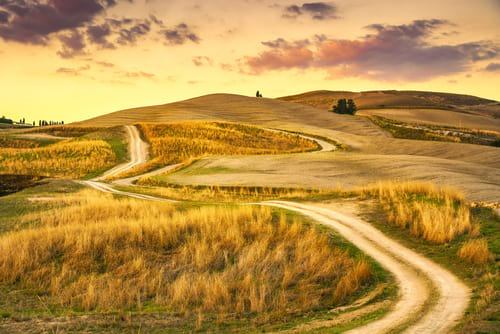
Things to note as a driver
The Italian driving mentality
Decisive driving (to put it lightly) is the norm, so Italian drivers will be much more used
to this type of road user. Being extremely hesitant behind the wheel will not only confuse
local drivers, it may also mean that you never get anywhere. Unlike other countries, drivers
here are unlikely to let you out!
Tailgating is fairly common so don’t get anxious if this happens to you. Don’t feel under
pressure to speed up – they will pass as soon as the opportunity arises.
The city centre rules
ZTLs (reduced traffic zones) are common in most cities where the aim is to reduce congestion
and help preserve the historical centres. Drive within these and your number plate will be
caught on camera, then you’ll be sent a large fine via the rental company. Look carefully at
any GPS routes, as they may not know to avoid these areas which could result in you driving
straight into one.
Road trip tips
- Trucks aren’t allowed to drive on Sundays, making it a good day to travel.
- Fuel is expensive in Italy, especially when compared to places such as the USA.
- You must have your headlights switched on at all times of day if you are driving on an
out of town road such as an autostrada. - Check whether your hotel offers parking – this can be a real money-saver if you are able
to park up your rental car for free.

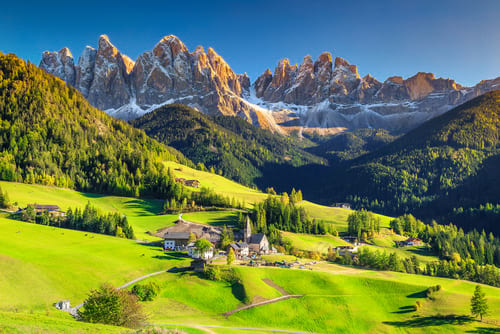
Quick driving guides
A guide to speed limits
| Type of road | Kilometres per hour |
|---|---|
| Highway | 130 |
| Non-major highway | 110 |
| Local roads | 90 |
| Urban areas | 50 |
Red signs with white writing on designate the maximum speed, however blue signs with white
writing display the minimum speed limit. Don’t get these confused!
A guide to Italian road signs
| Colour of road sign | Type of road sign |
|---|---|
| Green | autostrada (toll roads) |
| Blue | main highways (free) |
| Brown | tourist attractions |
| Yellow / white | restaurants |
Viamichelin is a great website if you want to calculate the price of toll
roads on your route.
A guide to Italian parking
Blue: paid parking (there will be a metre nearby where you can buy a
ticket).
White: free parking (these are rare, so make sure you always
check the signs. A faded blue bay can sometimes be mistaken for a white
bay).
Yellow: residents or disabled badge holders.
In general, parking can be one of the trickiest parts of hiring a car in Italy. Plan ahead by
using websites such as Parcheggio (the name of which is also the word for parking
in Italian), so you know ahead of time where the multi-storey car parks are.
Milan
Fast car hire facts
| Cheapest / most expensive months | Average cost per day of car hire* |
|---|---|
| November | £13.30 |
| July | £34.30 |
(*based on a 7+day rental)
What’s it famous for?
People are drawn from all over the world to see
Milan because of its Duomo – the architectural
masterpiece which took nearly 600 years to build. This colossal church is the
third-largest in the world. Remember to book tickets in advance (people that don’t are
disappointed every day) as well as dress appropriately. The adjacent Piazza del Duomo is
a great place to enjoy a coffee, people watch and soak in the gothic magnificence.
Where to visit
Santa Maria delle Grazie is the place to get your Da
Vinci fix – the famed mural of The Last Supper is housed here. Again, this is one to
book well in advance.
Local tips
- Free WiFi is available throughout the city centre.
- Some restaurants have dress codes, so pack something relatively fancy if you want a
nice meal out. - Happy hour includes free food (stuzzichini) along with your drinks.


Other Italian cities

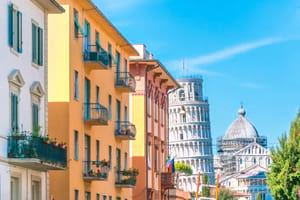
Pisa
| Cheapest / most expensive month | Average cost per day of car hire* |
|---|---|
| January | £10.90 |
| July | £31.00 |
(*based on a 7+day rental)
Driving tip
Parking up in Pisa isn’t
usually too bad, and paid parking is reasonably priced. Once you’re within the city, it’s a
great place to wander as it isn’t too big, and you’ll see the most on foot.
Tourist tip
Don’t underestimate the climb to the top of the Leaning
Tower. There’s nearly 300 steps and being a spiral staircase, you’re likely to get dizzy.

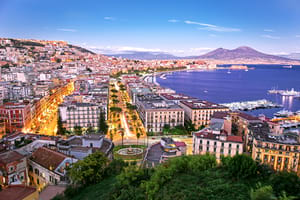
Naples
| Cheapest / most expensive month | Average cost per day of car hire* |
|---|---|
| February | £10.50 |
| August | £33.00 |
(*based on a 7+day rental)
Driving tip
Despite what you might think, driving from Naples to Pompeii (which is a 30 minute drive) is a really
good idea. The scenery is stunning and there’s plenty of parking!
Tourist tip
Be sure to try Pastiera Napoletana, it’s the most popular
cake in the city. Grab one on the go whilst enjoying a leisurely stroll (or passeggiata).

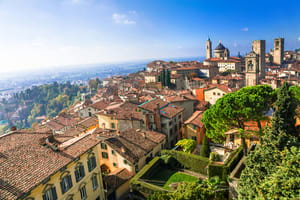
Bergamo
| Cheapest / most expensive month | Average cost per day of car hire* |
|---|---|
| November | £11.30 |
| July | £27.80 |
(*based on a 7+day rental)
Driving tip
Bergamo is the best-value
major location to hire a car in Italy throughout the year, so it makes perfect sense to grab
a bargain rental while in the area. Try Orio al Serio Airport for the best prices.
Tourist tip
Although Città Alta is a must-see, you’ll get far better
value accomodation in the Città Bassa. Take the funicular railway to the top of the city –
it’s a great part of the Bergamo experience!
Book your car hire now
 Book by phone
Book by phone
+44 203 3186 960

Rome
Fast car hire facts
| Cheapest / most expensive month | Average cost per day of car hire* |
|---|---|
| February | £13.50 |
| July | £32.00 |
(*based on a 7+day rental)
What’s it famous for?
The Roman Empire has left its mark on the city
of Rome, and the food is also known across the world for
its quality.
Where to visit
As well as the main tourist drags, seek out the
quieter cobbled alleyways and you’ll see another side to the city.
Local tips
- Get to know the names of hotel staff. Forming simple friendships goes a long way in
Italy. - Seek out the drinking fountains and you won’t have to pay a penny for water.
- Many museums are free on the first Sunday of the month.
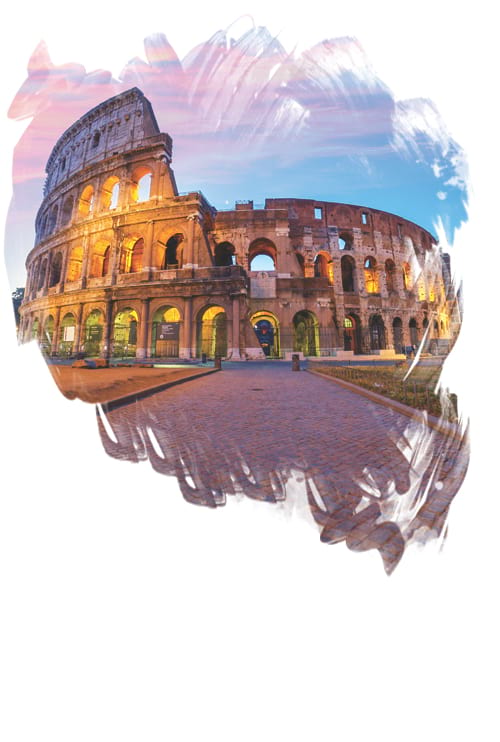

Other Italian destinations to visit

Sardinia
A large island off the West Coast
A beach lover’s
retreat, Sardinia has over 2,000km of coastline.

Venice
A famous canal-dominated romantic break
No matter
its popularity, Venice’s enchanting aura is everlasting.


Sicily
The largest Mediterranean island
The football to
Italy’s boot, Sicily is great for lovers of both sea and
land.

Verona
Situated in the north of Italy
Grand enough to be
the setting of Romeo and Juliet, Verona is a pretty and
historic city.






